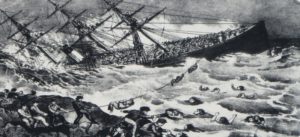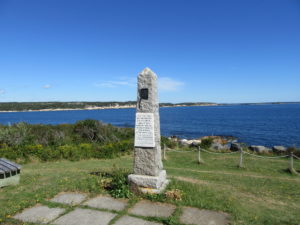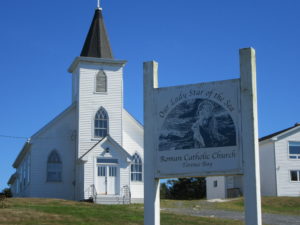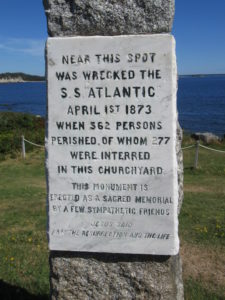(GPS Sandy Cove 44°27’56″N 63°42’38″W: Terence Bay 44°27’48″N 63°43’20″W)

Rescuing Victims of S.S. Atlantic shipwreck, April 1, 1873 – Public Archives of Nova Scotia
Canada’s Irish history is renowned for its long, sad list of lost ships both at sea and along its Maritime shorelines. Ships such as the Pallas, Mistrel, Anglo Saxon, Sybelle, Hannah, Carricks and Dispatch were victims of Mother Nature’s wrath or bad luck from storms, ice and fog, poor navigation or a series of unfortunate mistakes that together brought death to their Irish passengers throughout the 19th century. (Note: The Titanic is the worst event causing loss of Irish lives at sea).
Until my husband and I visited Sandy Cove with its sea wall, mass grave and plaques commemorating the 562 lives lost from the S.S. Atlantic wreck, we didn’t fully understand the role that Lower Prospect’s geography played concerning the events of that fateful night of April 1, 1873 nor the proximity between Sandy’s Cove and Terence Bay.
The S.S. Atlantic, the most popular passenger ship in Ismay’s prestigious White Star Line, left Queenstown, Ireland on March 20, 1873, heading for New York. Battling fierce early spring storms for several days off the coast of Nova Scotia, Captain James A. Williams changed course for Halifax to wait out the rough seas, for safety’s sake, and to replenish supplies, especially coal. Unfortunately, while the captain slept, in the early morning hours of April Fool’s Day, the S.S. Atlantic steered a wrong course in heavy weather, failed to make depth soundings, ultimately sending the ship at full speed onto Nova Scotia’s rocky shore at Lower Prospect Bay.

S.S. Atlantic Memorial
Within minutes of impact on Golden Rule Rock, there was little left of the ship still above water, with all her lifeboats gone. Passengers, in the middle of the stormy night, fought to save their lives by swimming to shore or by crossing over the waves on ropes thrown to the wreck by local fisherman. Of 950 passengers and crew, 562 men, women and all children, save one small boy — John Hindley — died that early morning – more than any other wreck in Canadian history up to that moment in time. The survivors were taken ashore at Sandy’s Cove.

Our Lady Star of the Sea Catholic Church, Terence Bay, Nova Scotia
Today, the wreck of the S.S. Atlantic is commemorated with a memorial plaque that describes the ordeal. Park benches, a gazebo and a shoreline boardwalk provide for a peaceful park setting to help create a somber, reflective mood. The S.S. Atlantic Heritage Park and Interpretation Center manages a small on-site store providing historical pictures and documents for visitors and, of course, maintains the park itself. Of those bodies not claimed by family, the kind people of Terence Bay buried 277 Protestant English and Irish victims in a mass grave; their coffins paid for by the Canadian government and the White Star Line. Less than a mile away, 170 Catholic bodies were laid to rest at the Star of the Sea cemetery. Incredibly, some survivors, exhausted by their ordeal but not wanting to burden the kind residents of Terence Bay, walked to Halifax. They WALKED to Halifax.
The Ismay Family erected a plinth at the shipwreck site in 1915. Its plaque reads:
“The SS Atlantic was a ship of Thomas Henry Ismay’s White Star Line. The Ismay family erect this monument in 1915 in memory of those who perished.”
A plaque beneath the Ismay tribute reads:

Plaque Remembrance for SS Atlantic Victims
“Near this spot was wrecked the S.S. ‘Atlantic’ April 1st, 1873 when 562 persons perished of whom 277 were interred in this churchyard. This monument is erected as a sacred memorial by a few sympathetic friends. Jesus said, ‘I AM the Resurrection and the Life.”
While the memory of those who died as a result of the S.S. Atlantic tragedy has been honoured in the S.S. Atlantic Heritage Park, the 170 victims buried in Our Lady Star of the Sea Catholic cemetery have a much more modest remembrance. There is a plinth at the back of the cemetery with a simple plaque that reads: “In memory of S.S. Atlantic victims April 1, 1873.” In front of the plinth is a large unmarked undulating field where rows of bodies were interred.
